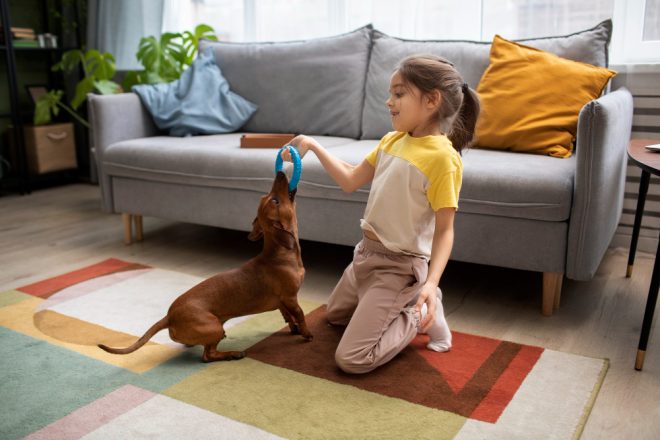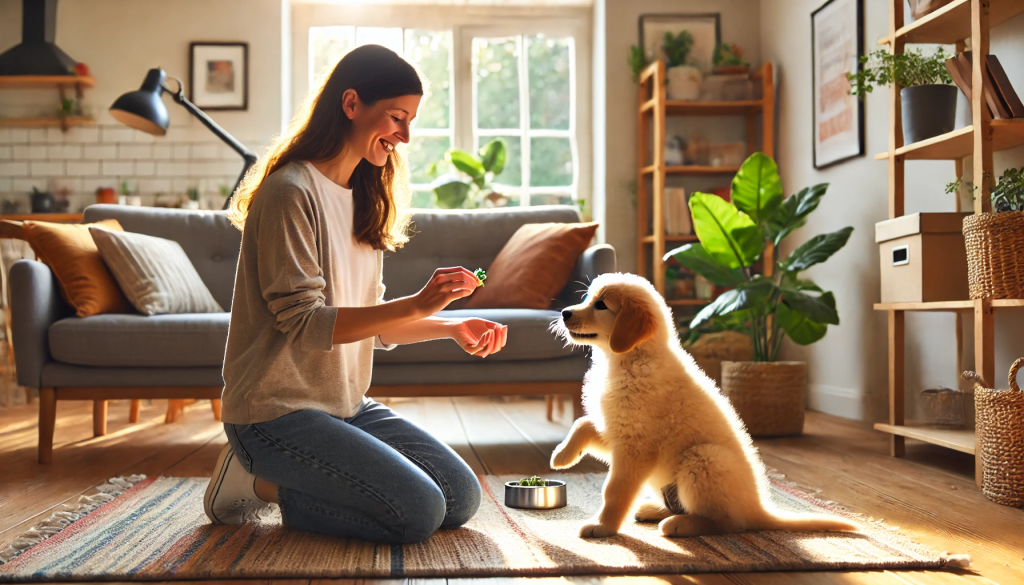
Bringing home a new puppy is exciting, but one of the very first challenges you’ll face is house training. Teaching your pup where and when to go to the bathroom is not only important for keeping your home clean it also sets the stage for good habits and a strong bond between you and your dog.
The good news? With the right approach, you can house train your puppy quickly and without stress. Experts agree that the keys are consistency, patience, routine, and positive reinforcement. In this guide, we’ll walk you through simple steps that make the process faster and easier for both you and your puppy.
Understanding the Basics of Puppy House Training
Puppies are like babies, they do not have full control over their bodies yet. Because their bladders are small and they can not hold it for long, they need to go out often. Sometimes it takes 1 to 2 hours. That is why making a structure and routine is very important when you are new to this.
Some may pick it up in just a few weeks, while others can take several months before they’re fully trained and it is complete. The most important thing is being patient and setting realistic expectations. Remember: accidents will happen, but with the right consistency and encouragement, your puppy will get the hang of it.
Step-by-Step Guide to Quick and Effective House Training
Choose a Dedicated Potty Spot
Pick one spot where your puppy will always go to the bathroom. If you’re training outside, take them to the same patch of grass each time. If you’re indoors, use a puppy training pad in the same area. Puppies learn by smell and repetition, so using the same place helps them understand faster.
Establish a Consistent Schedule
Puppies can’t “hold it” for long, so they need lots of bathroom breaks. Take your pup out after meals, naps, playtime, and at least every 1 to 2 hours. Feeding at regular times makes potty breaks more predictable and easier to manage.
Use Verbal Cues and Commands
Choose a simple phrase like “go potty” or “do your business” and say it every time you take your puppy to the potty spot. Over time, they’ll connect your words with the action, making it easier for them to understand what you expect.
Reward Immediately
The moment your puppy finishes going in the right spot, praise them or give a small treat. Timing is important. If you wait too long, they won’t connect the reward to the action. A happy voice, a belly rub, or playtime also works as positive reinforcement.
Supervise and Manage Environment
Keep a close eye on your puppy indoors. If they start sniffing, circling, or whining, that usually means they need to go. By watching for these signals, you can get them outside before an accident happens. Also, feeding them at the same times every day helps create a reliable bathroom schedule.
Crate Training as a Helpful Tool
A crate can be a big help because most puppies won’t go to the bathroom where they sleep. Make sure the crate is the right size big enough to stand, turn, and lie down, but not so large that they can potty in one corner. Use the crate for short periods and take your puppy outside as soon as you let them out. Over time, this teaches them to “hold it” and wait for the right spot.
Handling Accidents with Patience
Accidents will happen, it’s part of the process. When they do, clean the area well to remove odors so your puppy won’t be tempted to go there again. Never punish or scold your puppy, because it only confuses them. Instead, calmly redirect them to the right spot next time.

ALT TAG: A cozy living room scene where a person is training their playful puppy.
Common Challenges and How to Overcome Them
Not all puppies learn at the same pace. Some pick up house training quickly, while others need more time. If your puppy is taking longer, don’t worry, this is normal. Stick to the routine and stay patient.
Nighttime accidents are also common. Since puppies can’t hold their bladder very long, you may need to set an alarm to take them out once or twice during the night until they grow older.
Certain breeds, or even older rescue dogs, may seem more stubborn or harder to train. In these cases, patience and consistency are even more important. Keep rewarding the right behavior and avoiding punishment, and your puppy will eventually catch on.
Expert Tips for Success
- Stay consistent, even with setbacks. Don’t change the routine just because your puppy has accidents.
- Get the whole family involved. Everyone should use the same commands and follow the same rules so your puppy doesn’t get confused.
- Keep training positively. When your pup feels safe and rewarded, they’ll trust you more and learn faster.
How Long Does House Training Take?
Most puppies can be house trained in about 1 to 2 months if you stick to a schedule. For some, it may take up to 6 months. The exact timing depends on things like the breed, the puppy’s age, and how consistent you are with training. Remember: no two puppies are the same, so progress can vary.
Conclusion
House training a puppy isn’t instant, and I’ve learned firsthand that accidents are part of the deal. What matters most is keeping a steady routine, staying patient, and rewarding good behavior every single time. Before you know it, your puppy will start heading to the door on their own and that’s when you realize all the effort was worth it. With consistency and positivity, every pup can grow into a well-trained, trusted companion.
FAQs
1. How long does it take to house train a puppy?
Most puppies can be house trained in 1–2 months with a consistent routine, though some may take up to 6 months depending on age, breed, and training consistency.
2. What is the fastest way to house train a puppy?
The quickest way is to use a regular schedule, take your puppy to the same potty spot every time, give a clear verbal cue, and reward them immediately after they go.
3. Should I use puppy pads or take my puppy outside?
Both methods can work. Puppy pads are useful for apartments or bad weather, but outdoor training helps your puppy learn faster where they should go long-term.
4. Is crate training good for house training?
Yes, crate training is highly effective. Since puppies usually won’t go where they sleep, a crate teaches them to hold their bladder until you take them outside.
5. How do I stop my puppy from having accidents at night?
Take your puppy out right before bedtime and again during the night if needed. As they grow, they’ll be able to hold it longer, and accidents will become less frequent.
RELATED POST: How to Save a Choking Pet Fast: Dogs and Cats Guide
GIPHY App Key not set. Please check settings